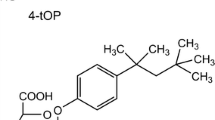Summary
Some of the target organs for nitrosamine carcinogenicity have a low activating capacity but many carcinogenic nitrosamines can be activated in the liver. Conjugates, such as phosphates, are chemically accessible reaction products of 1-OH-nitrosamines, and are either potential detoxication products or potential transport forms for activated nitrosamines.14C-labeled 1-(N-ethyl-N-nitrosamino)ethyl phosphate was tested for its ability to enter primary rat hepatocytes but no uptake was detectable. No uptake was observable into fibroblasts and human leukocytes.N-Nitrosomethylbenzylamine is efficiently 1-C-hydroxylated by hepatocytes but the corresponding 1-C-phosphate was detectable neither in the cells nor in the surrounding medium.N-Nitrosamino-1-phosphates, unlike 1-glucuronides, therefore, do not seem to be important for nitrosamine toxicokinetics.
Similar content being viewed by others
Abbreviations
- MNEP:
-
1-(N-methyl-N-nitrosamino)ethyl phosphate
- ENEP:
-
1-(N-ethyl-N-nitrosamino)ethyl phosphate
- [14C]ENEP:
-
1-(N 14C]ethyl-N-nitrosamino)-ethyl phosphate)
- N[14]MBzA:
-
N-nitroso-[14C]methylbenzylamine
References
Anwer MS, Kroker R, Hegner D (1976) Cholic acid uptake into isolated rat hepatocytes. Hoppe-Seylers Z Physiol Chem 357:1477–1486
Appel KE, Frank N, Wiessler M (1981) Metabolism of nitrosoace-toxymethylmethylamine in liver microsomes. Biochem Pharmacol 30:2767–2772
Braun H, Wiessler M (1977) Synthesis of14C-labelled compounds. II. Synthesis of14C-methylacetoxymethyl-nitrosamine. J Labelled Compd Radiopharm 13:379–383
Frank N, Wiessler M (1986) N-nitroso-hydroxyalkyl-alkylamine phosphate esters — a new class ofN-nitroso compounds. Carcinogenesis 7:365–369
Frank N, Janzowsky C, Wiessler M (1980) Stability of nitroso-acetoxy methylmethylamine in vitro systems and in vivo and its excretion by the rat organism. Biochem Pharmacol 29:383–387
Frank N, Wiessler M, Pool BL, Freí E (1987) CouldN-nitrosamino phosphates be transport forms of activated nitrosamines. In: Bartsch H, O'Neill IK, Schulte-Hermann R (eds) The relevance ofN-nitroso compounds to human cancer. Exposures and mechanisms. IARC Scientific Publications, no 84. IARC, Lyon, pp 162–164
Frank N, Frei E, Wiessler M (1989) Metabolism ofN-nitroso-hydroxyethyl-alkylamine phosphate esters in the rat. Toxicology 57:59–67
Keenan TH, Weinkam RI (1985) The half-lives of alkylating intermediates from diethylnitrosamine andN-nitrosopyrrolidine: a method for the measurement of metabolically generated reactive species. Toxicol Appl Pharmacol 78:316–320
Lai DY, Arcos JC (1980) Dialkylnitrosamine bioactivation and carcinogenesis. Life Sci 27:2149–2165
Lijinsky W (1987) Structure-activity relations in carcinogenesis byN-nitroso compounds. Cancer Metastasis Rev 6:301–356
Mehta R, Labuc GE, Archer MC (1984) Tissue and species specificity of the microsomal metabolism ofN-nitrosomethyl-benzylamine. In: O'Neill IK, von Borstel RC, Miller CT, Long J, Bartsch H (eds)N-nitroso compounds: occurrence, biological effects and relevance to human cancer. IARC Scientific Publications no. 57. IARC, Lyon, pp 473–478
Mochizuki M, Anjo T, Sekiguchi N, Ikarashi A, Suzuki A, Wakabayashi Y, Okada M (1986) Solvolysis ofN-nitroso-N-(1-acetoxyalkyl)alkylamines in phosphate buffer: characterization and mutagenicity ofN-nitroso-(1-phosphonooxylalkyl)alkylamines. Chem Pharm Bull 34:3956–3959
Mulder GI (1979) Detoxification or toxification? Modification of the toxicity of foreign compounds by conjugation in the liver. Trends Biol Sci April: 86–90
Pool BL, Wiessler M (1981) Investigations on the mutagenicity of primary and secondaryα-acetoxynitrosamines withSalmonella typhimurium: activation and deactivation of structurally related compounds by S-9. Carcinogenesis 2:991–997
Preussmann R, Stewart BW (1984)N-Nitroso carcinogenesis. In: Searte CE (ed) Chemical carcinogens (ACS Symposium Series), vol. 182. American Chemical Society, Washington, pp 643–828
Preussmann R, Wiessler M (1987) The enigma of the organ-specificity of carcinogenic nitrosamines. Trends Pharmacol Sci 8:185–189
Roller PP, Shimp DR, Keefer LK (1975) Synthesis and solvolysis of methyl(acetoxymethyl)nitrosamine Tetrahedron Lett 25:2065–2068
Singer B, Grunberger D (1983) Molecular biology of mutagens and carcinogens. Plenum, New York
Skipper PL (1978) Synthesis of14C-methylbenzylnitrosamine and methyl-14C-benzylnitrosamine. J Labelled Compd Radiopharm 15:575–579
Wiessler M (1974) Syntheseα-funktioneller Nitrosamine. Angew Chemie 86:817–818
Wiessler M, Rossnagel G (1987)αGlucoronides ofN-nitroso-methylbutylamine. In: Bartsch H, O'Neill IK, Schulte-Hermann R The relevance ofN-nitroso compounds to human cancer. Exposure and mechanisms. IARC Scientific Publication no. 84. IARC, Lyon, pp 170–172
Wiessler M, Habs M, Schmähl D (1978) Zur carcinogenen Wirkung vonN-Nitroso-Verbindungen. 7. Mitteilung. Z Krebsforsch 91:317–323
Wiessler M, Rossnagel G, Rugewitz-Blackholm B (1984) Conjugates ofN-nitroso-tert-butylmethylamine in urine. In: O'Neill IK, von Borstel RC, Miller CT, Long J, Bartsch H (eds)N-nitroso compounds: occurrence, biological effects and relevance to human cancer. IARC Scientific Publication no. 57. IARC, Lyon, pp 465–471
Author information
Authors and Affiliations
Additional information
Dedicated to Professor Dr. D. Schmähl on the occasion of his 65th birthday
Rights and permissions
About this article
Cite this article
Frei, E., Frank, N. & Wiessler, M. N-Nitrosamino phosphates are unlikely transport forms for activated nitrosamines. J Cancer Res Clin Oncol 116, 569–574 (1990). https://doi.org/10.1007/BF01637076
Received:
Accepted:
Issue Date:
DOI: https://doi.org/10.1007/BF01637076



